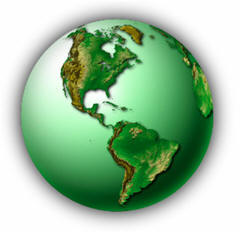|
Wastewater is “used” water
that is deposited into
drains by residents and
businesses. Flushing the
toilet, taking a shower, and
running the washing machine
are all examples of everyday
activities that produce
wastewater. This wastewater
drains down the sink or
toilet and travels through a
network of underground pipes
known as the sanitary sewer
system.
Your home is being serviced
by either 1) a sanitary and
a storm sewer or 2) a
combined sewer, a single
pipe which conveys both
sanitary sewage and storm
water. It is 99.94 percent
water, with only 0.06
percent of the wastewater
being dissolved and
suspended solid material.
The cloudiness of sewage is
caused by suspended
particles which, in
untreated sewage, range from
100 to 350 mg/l. A measure
of the strength of the
wastewater is biochemical
oxygen demand, or BOD5.
The BOD5 measures
the amount of oxygen
microorganisms require in
five days to break down
sewage. Untreated sewage has
a BOD5 ranging
from 100 mg/l to 300 mg/l.
Pathogens or disease-causing
organisms are present in
sewage. Coliform bacteria
are used as an indicator of
disease-causing organisms.
Sewage also contains
nutrients (such as ammonia
and phosphorus), minerals,
and metals. Ammonia can
range from 12 to 50 mg/l and
phosphorus can range from 6
to 20 mg/l in untreated
sewage.
The sewer systems are built
to follow the natural slope
of the land. This design
allows gravity to do most of
the work transporting the
wastewater to treatment
facilities. In some
situations, pump stations
are constructed in low-lying
areas to force the
wastewater uphill to the
treatment facility.
The average US citizen uses
approximately 100 gallons of
water per day. The organic
and inorganic material found
in this wastewater is too
abundant to be handled by
the environment. Therefore,
treatment of our wastewater
is an essential process that
prevents contamination and
destruction of waterways,
drinking water sources, and
natural water resources.
Sewage treatment is a
multi-stage process to
renovate wastewater before
it reenters a body of water,
is applied to the land, or
is reused. The goal is to
reduce or remove organic
matter, solids, nutrients,
disease-causing organisms,
and other pollutants from
wastewater. Each receiving
body of water has limits to
the amount of pollutants it
can receive without
degradation. Therefore, each
sewage treatment plant must
hold a permit from DHEC
listing the allowable levels
of BOD5,
suspended solids, coliform
bacteria, and other
pollutants. The discharge
permits are called NPDES
(National Pollutant
Discharge Elimination
System) permits.
1. Preliminary treatment
Upon arrival via the sewer
system, the wastewater is
sent through a bar screen,
which removes large solid
objects such as sticks and
rags. Leaving the bar
screen, the wastewater flow
is slowed down entering the
grit tank. This allows sand,
gravel, and other heavy
material that was small
enough not to be caught by
the bar screen to settle to
the bottom. All the
collected debris from the
grit tank and bar screen is
disposed of at a sanitary
landfill or recycled.
2. Primary treatment
Primary treatment is the
second step in wastewater
treatment. It allows for the
physical separation of
solids and greases from the
wastewater. The screened
wastewater flows into a
primary settling tank where
it is held for several
hours. This allows solid
particles to settle to the
bottom of the tank and oils
and greases to float to the
top.
3. Secondary treatment
Secondary treatment is a
biological treatment process
that removes dissolved
organic material from
wastewater. The partially
treated wastewater from the
settling tank flows by
gravity into an aeration
tank. Here it is mixed with
solids containing
micro-organisms that use
oxygen to consume the
remaining organic matter in
the wastewater as their food
supply. The aeration tank
uses air bubbles to provide
the mixing and the oxygen,
both of which are needed for
the micro-organisms to
multiply.
From here the liquid
mixture, composed of solids
with micro-organisms and
water, is sent to the final
clarifier. Here the solids
settle to the bottom where
some of the material is sent
to the solids handling
process, and some is
recirculated to replenish
the population of
micro-organisms in the
aeration tank to treat
incoming wastewater.
4. Final treatment
Wastewater
that remains is disinfected
to kill harmful
micro-organisms before being
released into receiving
waters. Although there are
many methods available to
kill these micro-organisms,
chlorine and ultraviolet
disinfection are the most
widely used.
Dechlorination occurs in the
final wastewater treatment
step. A solution of sodium
bisulfite is added to the
chlorinated effluent to
remove residual chlorine.
Following disinfection and
dechlorination, the treated
wastewater (now called final
effluent) can be returned to
the receiving waters from
which it came. The flow is
conveyed to an outfall and
discharged through a series
of diffusers into a surface
water body or stream.
5. Solids processing
Primary
solids from the primary
settling tank and secondary
solids from the clarifier
are sent to the digester.
During this process,
micro-organisms use the
organic material present in
the solids as a food source
and convert it to
by-products such as methane
gas and water. Digestion
results in a 90% reduction
in pathogens and the
production of a wet
soil-like material called “biosolids”
that contain 95-97% water.
To remove some of this water
and reduce the volume,
mechanical equipment such as
filter presses or
centrifuges are used to
squeeze water from the
biosolids. The biosolids are
then sent to landfills,
incinerated, or beneficially
used as a fertilizer or soil
amendment. |


